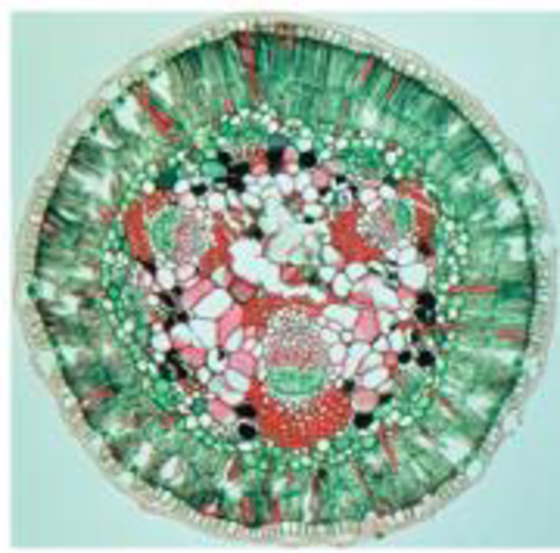
Campbell Biology In Focus, Loose-leaf Edition (3rd Edition)
3rd Edition
ISBN: 9780134895727
Author: Lisa A. Urry, Michael L. Cain, Steven A. Wasserman, Peter V. Minorsky
Publisher: PEARSON
expand_more
expand_more
format_list_bulleted
Textbook Question
Chapter 28, Problem 10TYU
SYNTHESIZE YOUR KNOWLEDGE

This stained light micrograph shows a cross section through a plant organ from Hakea purpurea, a shrub native to some arid regions of Australia (a) Review Figures 28.14, 28.17, and 28.18 to identify whether this is a root, leaf or stem Explain your reasoning (b) How might this organ be an adaptation to dry conditions?
Expert Solution & Answer
Want to see the full answer?
Check out a sample textbook solution
Students have asked these similar questions
(A) 25
20
20
15
NPP (Mg C/ha/yr)
10
10
5
0
0
2,000
4,000
6,000
ECOLOGY 4e, Figure 20.11 (Part 1)
2017 Sinauer Associates, Inc.
Average annual precipitation (mm)
8,000
explain the cascade of events (starting with relaxing trade winds) that occurs during El Niño in the eastern Pacific (off the coasts of California/North America and Peru/South America) and which lead to food-chain collapse
- start with changes in the physical/oceanographic conditions, andthen systematically describe the cascading effects at each level of the food chain
-
3) Which statement(s) about the Pacific Decadal Oscillation (PDO) is/are TRUE? CIRCLE ALL
THAT APPLY.
A. It is a major driver of salmon populations in the Pacific
B. It affects sea surface temperatures in the eastern Pacific
C. Its cycles typically do not last as long as those of ENSO
D. Evidence that it has occurred over many centuries has been gathered from tree
ring data
Chapter 28 Solutions
Campbell Biology In Focus, Loose-leaf Edition (3rd Edition)
Ch. 28.1 - Prob. 1CCCh. 28.1 - WHAT IF? If humans were photoautotrophs, making...Ch. 28.1 - Prob. 3CCCh. 28.2 - Prob. 1CCCh. 28.2 - Prob. 2CCCh. 28.2 - Prob. 3CCCh. 28.3 - Prob. 1CCCh. 28.3 - Prob. 2CCCh. 28.3 - Prob. 3CCCh. 28.4 - A sign is hammered into a tree 2 m from the trees...
Ch. 28.4 - Would you expect a tropical tree to have distinct...Ch. 28.4 - Prob. 3CCCh. 28 - Most of the growth of a plant body is the result...Ch. 28 - Prob. 2TYUCh. 28 - Heartwood and sapwood consist of A. bark. B....Ch. 28 - Prob. 4TYUCh. 28 - Which of the following would not be seen in a...Ch. 28 - Prob. 6TYUCh. 28 - SCIENTIFIC INQUIRY Grasslands typically do not...Ch. 28 - Prob. 8TYUCh. 28 - FOCUS ON ORGANIZATION In a short essay (100-150...Ch. 28 - SYNTHESIZE YOUR KNOWLEDGE This stained light...
Additional Science Textbook Solutions
Find more solutions based on key concepts
Single penny tossed 20 times and counting heads and tails: Probability (prediction): _______/20 heads ________/...
Laboratory Manual For Human Anatomy & Physiology
An obese 55-year-old woman consults her physician about minor chest pains during exercise. Explain the physicia...
Biology: Life on Earth with Physiology (11th Edition)
The validity of a scientific law.
Physical Universe
Describe the role and impact of microbes on the earth.
Microbiology Fundamentals: A Clinical Approach
On what molecule does the anticodon appear? Explain the role of this molecule in protein synthesis.
Human Physiology: An Integrated Approach (8th Edition)
Knowledge Booster
Learn more about
Need a deep-dive on the concept behind this application? Look no further. Learn more about this topic, biology and related others by exploring similar questions and additional content below.Similar questions
- 4.arrow_forward2arrow_forward1. 2. 3. Marine fish cells are hypotonic compared to their seawater environment; their cells lose water by osmosis and gain solutes. If you add heterotrophic respiration and autotrophic respiration together and then subtract that value from gross primary productivity, then you have a more refined estimate of ecosystem carbon storage than NEE. Differential heating due to the earth's tilt generates the global wind AND oceanic circulation patternsarrow_forward
- KD 200- 116- 66- Vec ATF6 (670) ATF6 (402) ATF6 (373) ATF6 (366) I I 45- 1 2 3 4 5 ATFG (360) (e/c) 9V ATFG (402) g ant- ATF anti-KDEL DAPI barrow_forwardWestern blot results: what information can you get? Presence of proteins of your interest Levels of protein expression Levels of protein activation (must use activation state-specific antibody) Decreased function of the ATM kinase in aging mice. A C57BL/6 female 6 month Con IR 20 month C57BL/6 male 6 month 28 month Con IR Con IR Con IR p-ATM (S1981) ATM P-p53 (ser18) Actinarrow_forwardDoes it show the level of proteins? What about the amount? Levels of protein activation? How can you tell? Does the thickness tell you anything? What about the number of the lines?arrow_forward
arrow_back_ios
SEE MORE QUESTIONS
arrow_forward_ios
Recommended textbooks for you
 Biology (MindTap Course List)BiologyISBN:9781337392938Author:Eldra Solomon, Charles Martin, Diana W. Martin, Linda R. BergPublisher:Cengage Learning
Biology (MindTap Course List)BiologyISBN:9781337392938Author:Eldra Solomon, Charles Martin, Diana W. Martin, Linda R. BergPublisher:Cengage Learning Biology: The Dynamic Science (MindTap Course List)BiologyISBN:9781305389892Author:Peter J. Russell, Paul E. Hertz, Beverly McMillanPublisher:Cengage Learning
Biology: The Dynamic Science (MindTap Course List)BiologyISBN:9781305389892Author:Peter J. Russell, Paul E. Hertz, Beverly McMillanPublisher:Cengage Learning Biology 2eBiologyISBN:9781947172517Author:Matthew Douglas, Jung Choi, Mary Ann ClarkPublisher:OpenStax
Biology 2eBiologyISBN:9781947172517Author:Matthew Douglas, Jung Choi, Mary Ann ClarkPublisher:OpenStax- Basic Clinical Lab Competencies for Respiratory C...NursingISBN:9781285244662Author:WhitePublisher:Cengage
 BiochemistryBiochemistryISBN:9781305577206Author:Reginald H. Garrett, Charles M. GrishamPublisher:Cengage Learning
BiochemistryBiochemistryISBN:9781305577206Author:Reginald H. Garrett, Charles M. GrishamPublisher:Cengage Learning

Biology (MindTap Course List)
Biology
ISBN:9781337392938
Author:Eldra Solomon, Charles Martin, Diana W. Martin, Linda R. Berg
Publisher:Cengage Learning

Biology: The Dynamic Science (MindTap Course List)
Biology
ISBN:9781305389892
Author:Peter J. Russell, Paul E. Hertz, Beverly McMillan
Publisher:Cengage Learning

Biology 2e
Biology
ISBN:9781947172517
Author:Matthew Douglas, Jung Choi, Mary Ann Clark
Publisher:OpenStax

Basic Clinical Lab Competencies for Respiratory C...
Nursing
ISBN:9781285244662
Author:White
Publisher:Cengage

Biochemistry
Biochemistry
ISBN:9781305577206
Author:Reginald H. Garrett, Charles M. Grisham
Publisher:Cengage Learning

Visual Perception – How It Works; Author: simpleshow foundation;https://www.youtube.com/watch?v=DU3IiqUWGcU;License: Standard youtube license